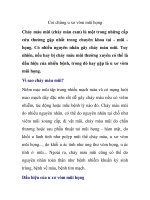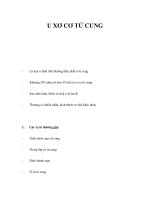u xơ mạch mũi
Bạn đang xem bản rút gọn của tài liệu. Xem và tải ngay bản đầy đủ của tài liệu tại đây (2.23 MB, 20 trang )
NASOPHARYNGEAL ANGIOFIBROMA
Tr ầ n T h ị Đ ỗ Q u y ê n - N T 44
INTRODUCTION
The most common of the benign nasopharyngeal neoplasm
0,5% of all head and neck tumours
Young males
(high androgen receptor (AR) expression
=> JNA is androgen dependent)
HISTOPATHOLOGY
Benign but highly vascular tumour
May be locally aggressive
Non-encapsulated, red to gray colored mass
A thick vascular network composed of irregular blood vessels within a connective fibrocellular tissue, rich in collagen and fibroblasts
Vessels are extremely variable in size and shape, without elastic fibers in their walls and
with a frequently incomplete muscolar layer
ORIGIN
- Sphenopalatine foramen
- Pterygopalatine fossa
- Choana
- Nasopharynx
CLINICAL PRESENTATION
Obstructive symptoms
Rhinorrhea
Chronic otomastoiditis
Headache, facial pain: secondarily to the blockage of paranasal sinuses
Proptosis and alteration of the vision: involvement of the orbit.
Swelling of the cheek
STAGING
Sessions classification:
• Stage I
Ia: limited to nasal cavity/nasopharynx
• Stage II
IIa: minimal extension through sphenopalatine foramen into pterygomaxillary fossa
Ib: extension into one or more paranasal sinuses
IIb: fills pterygomaxillary fossa bowing the posterior wall of the maxillary antrum anteriorly or extending into the orbit via
the inferior orbital fissure.
IIc: extends beyond pterygomaxillary fossa into infratemporal fossa
• Stage III: intracranial extension
NASAL ENDOSCOPY
May reveal a pale reddish mass
IMAGING FEATURE
Hollman - miller sign
(a) Axial enhanced CT scan demonstrating a large avidly enhancing lesion from a juvenile angiofibroma. There is widening of the sphenopalatine foramen (arrow) with marked distortion of the
posterior wall of the maxillary antrum. (b) A selective angiogram of the right external carotid artery shows a strong vascular blush in the vicinity of the internal maxillary artery (arrow) territory.
Fig 5. Nasopharyngeal angiofibroma. (a) axial gradient echo and (b) axial T2-weighted MR imaging of a left-sided tumor growing anteriorly into the nasal cavity (black arrow), dislocating the
ipsilateral maxillary sinus anteriorly (white arrow) and growing into the masticator space (black arrowhead).The rich vascularity of the tumour gives rise to the typical small dotted flow voids,
responsible for the salt and pepper appearence
ANGIOGRAPHY (DSA)
Useful in both defining the feeding vessels and in preoperative
embolization
• External carotid artery: the majority
• Internal maxillary artery
• Ascending pharyngeal artery
• Palatine arteries
• Internal carotid artery: less common, usually in larger tumours
• Ophthalmic artery
Differential diagnosis
Nasopharyngeal carcinoma
Rhabdomyosarcoma
TREATMENT
Embolism
Selective preoperative embolism of arterial feeding vessels has significantly decreased intraoperative hemorrhage facilitating resection of
larger tumors
Embolism is typically performed 24–72 hours prior to resection
Surgery
Surgical resection after embolism is the treatment of choice and may be performed using and open or endoscopic approaches
Radiation Therapy
May be an option when surgery is impossible or incomplete
CONCLUSION
Angiofibroma is the most common of the benign nasopharyngeal neoplasm
Young men
Origin: sphenopalatine foramen, pterygopalatine fossa, choana
Hypervascular tumor, Holmann-Miller sign









